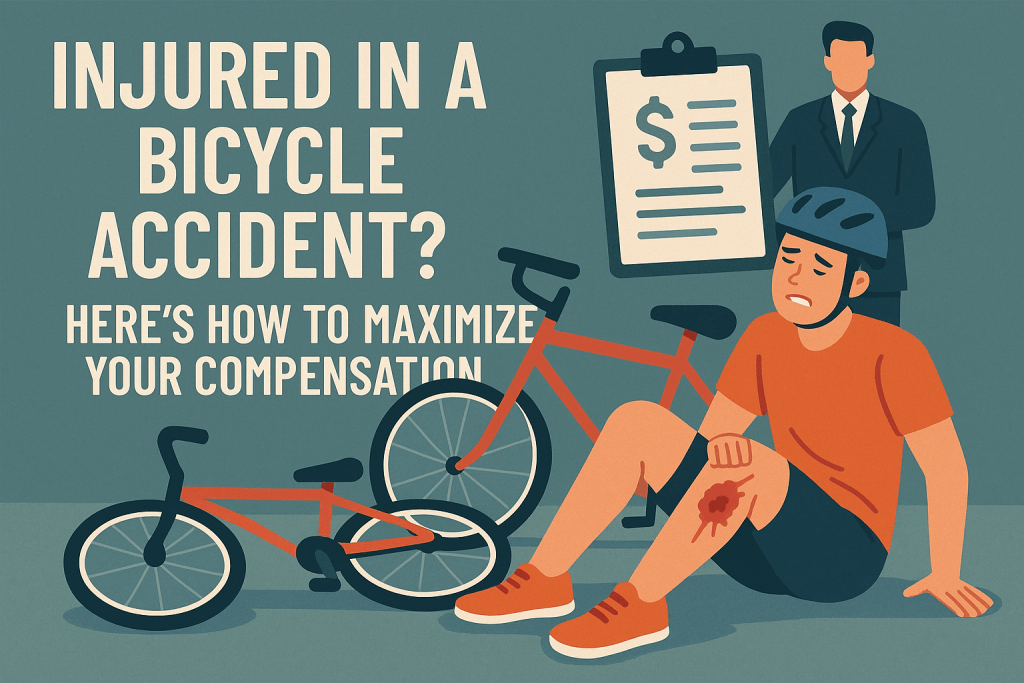Picture this: you’re cruising along on your bike, enjoying the breeze, when a car swerves or a pothole jolts you off course. In an instant, you’re on the ground, nursing injuries and wondering what’s next.
Bicycle accidents strike over 130,000 cyclists yearly in the U.S., turning a joyful ride into a challenge. Yet, this doesn’t have to be the end of your story. With the right steps, you can protect your health and claim the compensation you’re entitled to, transforming a rough moment into a powerful recovery. The following guide lights the way, helping you heal and thrive again.

Immediate Action: Prioritizing Your Health After a Bicycle Accident
If you’re injured in a bicycle accident, your well-being comes first. Check yourself for injuries, even if you feel okay at first. Adrenaline can mask pain, so don’t dismiss cuts, bruises, or soreness. If you hit your head or feel dizzy, seek medical attention right away, as concussions need prompt care.
Call emergency services if you can’t move safely or if the accident involves a vehicle. For less severe cases, visit a doctor soon after to assess hidden issues like fractures or internal damage. Follow their advice, whether it’s rest, medication, or imaging tests.
Getting treatment not only starts your healing but also creates a record tying your injuries to the crash, which helps later. Acting quickly ensures you’re on the path to feeling like yourself again.
Documenting the Scene: Building a Solid Foundation for Your Claim
Once you’re safe, gather details about the accident to strengthen your case. Note the time, location, and weather conditions, as these factors can influence fault. If a car was involved, get the driver’s name, contact info, insurance details, and license plate number. Take photos of your injuries, damaged bike, and the scene, including road hazards like potholes or debris.
Ask witnesses for their names and phone numbers, as their accounts can clarify what happened. Report the accident to the police, even for minor incidents, to create an official report. These steps lock in key evidence, making it easier to show how the crash occurred and who’s responsible, setting you up for a fair outcome.
Legal Guidance: Partnering with a Lawyer to Boost Your Compensation
After securing the basics, consider how a lawyer can elevate your claim. They understand local traffic laws and how they apply to cyclists, whether a driver ignored your right of way or a city neglected road maintenance.
A lawyer evaluates your case, calculates losses like healthcare costs and lost wages, and negotiates with insurance companies for a settlement that reflects your needs. A bicycle injury lawyer’s help is crucial when injuries lead to big medical bills, time off work, or disputes over fault.
If talks stall, they can take your case to court. Reach out if the other party denies blame or offers too little, or if your injuries affect your daily life long-term. Many offer free consultations, so you can weigh your options without risk.
For instance, if a driver claims you caused the crash, a lawyer gathers evidence to prove otherwise, ensuring you’re not shortchanged. Their support lets you focus on recovery while they handle the heavy lifting.
Pursuing Compensation: Understanding What You’re Entitled To
Knowing what compensation covers keeps you informed and empowered. You can claim medical expenses, from ER visits to physical therapy, ensuring your recovery isn’t a financial burden. Lost income counts too—if you miss work, you deserve payment for those days. Pain and suffering address the emotional toll, like anxiety about riding again or chronic discomfort from a lingering injury.
Property damage, such as a bent bike frame or broken helmet, also qualifies for reimbursement. A lawyer helps tally these amounts accurately, preventing insurers from lowballing you with an unfair offer.
Documentation like bills, pay stubs, and doctor’s notes backs up every dollar, so keep everything organized in one place. This process turns your losses into a clear figure, paving the way for a settlement that supports your fresh start and gets you back to the life you enjoy.
Detailed police reports, witness statements, and photos of the accident scene strengthen your case by proving fault and the extent of your injuries. Insurance companies look for gaps to minimize payouts, so having a complete record ensures you don’t leave money on the table. A strong claim increases your chances of fair compensation.
Long-Term Healing: Staying Strong After a Bicycle Accident
Recovery doesn’t end when the bruises fade, so stay proactive about your health. Follow your doctor’s plan, attending follow-ups to catch lingering issues like joint stiffness or headaches. Physical therapy can rebuild strength if you’ve got a muscle strain or a fracture. Mental health matters too—crashes can leave you wary of traffic, and a counselor can help you regain confidence.
Track all treatment costs and progress notes, as they reinforce your compensation claim if issues persist. Staying on top of healing and staying healthy after injury not only gets you back on your bike but also shows insurers or courts the full impact of the accident, strengthening your case.
Consistent care tackles setbacks like fatigue or reduced mobility, turning them into progress over time. If scars or nerve pain linger, specialists can ease those too, keeping your spirits up. Every visit builds resilience, proving you’re not just surviving but thriving. This persistent effort pays off, both in how you feel and what you recover financially.
Conclusion: Pedaling Toward a Brighter Future
A bicycle accident can feel like a detour, but these steps steer you toward recovery and justice. Prioritizing health gets you on solid ground, documenting the scene builds your case, and a lawyer maximizes your compensation when needed.
Pursuing what you’re owed and focusing on long-term healing completes the journey. You’re in control—each move you make turns a tough moment into a chance to come back stronger. If you’re dealing with an accident now, start today. Doctors and legal experts are ready to help, and a full recovery, financially and physically, is closer than you think.
Cassia Rowley is the mastermind behind advertising at The Bad Pod. She blends creativity with strategy to make sure ads on our site do more than just show up—they spark interest and make connections. Cassia turns simple ad placements into engaging experiences that mesh seamlessly with our content, truly capturing the attention of our audience.

